space station
Introduction
 an artificial structure placed in orbit and having the pressurized enclosure, power, supplies, and environmental systems necessary to support human habitation for extended periods. Depending on its configuration, a space station can serve as a base for a variety of activities. These include observations of the Sun and other astronomical objects, study of the Earth's resources and environment, military reconnaissance, and long-term investigations of the behaviour of materials and biological systems—including human physiology and biochemistry—in a state of weightlessness, or microgravity.
an artificial structure placed in orbit and having the pressurized enclosure, power, supplies, and environmental systems necessary to support human habitation for extended periods. Depending on its configuration, a space station can serve as a base for a variety of activities. These include observations of the Sun and other astronomical objects, study of the Earth's resources and environment, military reconnaissance, and long-term investigations of the behaviour of materials and biological systems—including human physiology and biochemistry—in a state of weightlessness, or microgravity.Small space stations are launched fully assembled, but larger stations are sent up in modules and assembled in orbit. To make the most efficient use of its carrier vehicle's capacity, a space station is launched vacant, and its crew members—and sometimes additional equipment—follow in separate vehicles. A space station's operation, therefore, requires a transportation system to ferry crews and hardware and to replenish the propellant, air, water, food, and such other items as are consumed during routine operations. Space stations use large panels of solar cells (solar cell) and banks of storage batteries as their source of electrical power. They also employ geostationary relay satellites for continuous communication with mission controllers on the ground and satellite-based positioning systems for navigation.
Space stations, from 1971Since 1971 nine space stations launched into a low orbit around Earth have been occupied for varying lengths of time. In chronological order they are Salyut 1, Skylab, Salyuts 3, 4, 5, 6, and 7, Mir, and the International Space Station (see table (Space stations, from 1971)).
Early concepts and plans
Between 1952 and 1954, in a series of articles in the popular magazine Collier's, the German-American rocket pioneer Wernher von Braun (Braun, Wernher von) presented his vision of a space station as a massive wheel-shaped structure that would rotate to generate “artificial gravity” from centrifugal force, sparing its crew of 1,000 scientists and engineers the drawbacks of weightlessness. It would be serviced by a fleet of winged spaceships employing nuclear engines. One of the station's primary tasks would be to assemble vehicles for expeditions to the Moon. That concept remained a popular portrait of humankind's future in space as late as 1968, when the American motion-picture director Stanley Kubrick (Kubrick, Stanley)'s classic science-fiction film 2001: A Space Odyssey depicted a spinning double-wheel station under construction above Earth. On a regular schedule, a fleet of commercial space planes flew people up to the station, from which they could catch a ferry to the Moon.
In Braun's day, the development of a space station was thought to be a preliminary stepping-stone to the Moon and planets, but, when Cold War politics prompted President John F. Kennedy (Kennedy, John F.) in 1961 to commit the United States to landing a man on the Moon before the decade was out, there was no time to pursue this logical route. Rather, a single spacecraft would be obliged to ride an expendable rocket into orbit and fly directly to its goal. Nevertheless, even as the National Aeronautics and Space Administration (NASA) plunged deeply into the Apollo program, it studied several space station strategies as part of an Apollo Applications Program, which would exploit vehicles built for the Moon race for more general orbital activities.
Even as 2001 was restating Braun's ambitious vision to the public, it already was obvious to space engineers that the first real space stations would have to be much simpler than their fictional counterparts. One NASA plan was to have an Apollo spacecraft dock with a spent rocket stage, whereupon its crew would pressurize the rocket's empty hydrogen-propellant tank with air and install scientific equipment that would turn it into a laboratory for several weeks of occupancy. The U.S. Air Force had its own plan to operate a Manned Orbiting Laboratory fitted with an advanced camera to facilitate military reconnaissance activities. In 1969, however, just as NASA attained Kennedy's goal of a manned lunar landing, President Richard M. Nixon (Nixon, Richard M.) canceled the Manned Orbiting Laboratory and restricted the Apollo Applications Program to a single station.
Like the U.S. military, the Soviet Union (Union of Soviet Socialist Republics) had a plan to put a series of reconnaissance stations in orbit by the 1970s. In 1969, with development running late for the large spacecraft that was to ferry crews and supplies to the station, Soviet officials decided to accelerate the program by employing the Soyuz spacecraft that had been developed during the failed attempt to win the Moon race. Moreover, because some of the systems needed for a military reconnaissance platform were not yet available, it was decided to initiate the program with a station equipped as a scientific laboratory.
Salyut 1: the first space station
The Soviet Union's space station design took the form of a stepped cylinder 14.6 metres (48 feet) long, with its widest section 4.25 metres (13.9 feet) in diameter. Although the station could be oriented arbitrarily, its maneuvering engine was located immediately behind the wide section, which thus came to be defined as the rear of the station. At the front end was a docking system for Soyuz ferries. Internally, apart from an air lock in the cylindrical front section, the station formed a single rectangular room. The name of the station program, Salyut (Russian: “salute”), was chosen to honour cosmonaut Yury Gagarin (Gagarin, Yury Alekseyevich)'s historic first orbit of Earth a decade earlier.
Salyut 1, which was launched April 19, 1971, atop a Proton rocket, was outfitted from the start to support two three-man crews for a total of two months over a six-month period. Although its first designated crew docked five days later in Soyuz 10, the cosmonauts could not open their ferry's hatch and had to return home. Once the fault had been rectified, the crew of Soyuz 11 spent 23 days aboard the station in June, although tragedy struck on the way home when a valve in the descent capsule allowed the air to leak out, and the three cosmonauts were killed. At that time, it was not Soviet practice for Soyuz cosmonauts to wear pressure suits. In redesigning the Soyuz to prevent such an accident from recurring, one seat had to be omitted to accommodate a life-support system for two pressure-suited cosmonauts.
Skylab
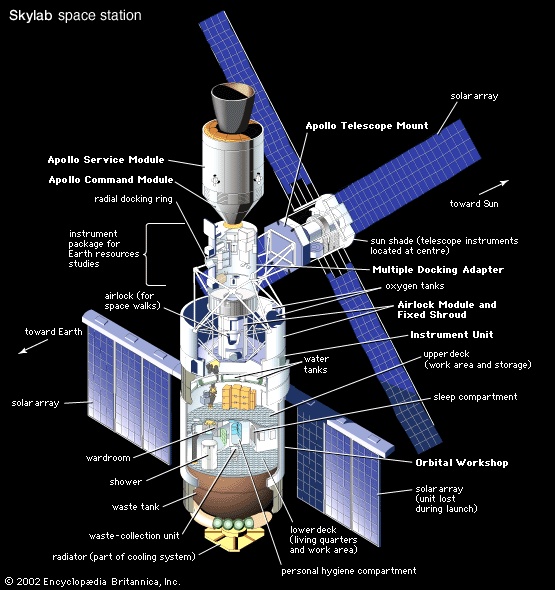 The only element of NASA's Apollo Applications Program that did not succumb to Nixon's budgetary cuts was Skylab. Its plan, which called for a ready-to-use scientific laboratory that had been prefabricated on the ground, replaced the earlier concept of outfitting the tank of a spent rocket in space. Apollo spacecraft would ferry the crews and provide a very limited resupply capability. Although similar in concept to Salyut in that its useful life was defined by its initial resources, Skylab was larger and much more capable because it used as its main habitat the upper stage of the Saturn V vehicle that had launched the Apollo spacecraft to the Moon. The station's primary scientific instrument was the Apollo Telescope Mount, which at the time was by far the most powerful solar telescope ever placed in orbit. It also carried apparatus for Earth resources observations and materials science research.
The only element of NASA's Apollo Applications Program that did not succumb to Nixon's budgetary cuts was Skylab. Its plan, which called for a ready-to-use scientific laboratory that had been prefabricated on the ground, replaced the earlier concept of outfitting the tank of a spent rocket in space. Apollo spacecraft would ferry the crews and provide a very limited resupply capability. Although similar in concept to Salyut in that its useful life was defined by its initial resources, Skylab was larger and much more capable because it used as its main habitat the upper stage of the Saturn V vehicle that had launched the Apollo spacecraft to the Moon. The station's primary scientific instrument was the Apollo Telescope Mount, which at the time was by far the most powerful solar telescope ever placed in orbit. It also carried apparatus for Earth resources observations and materials science research.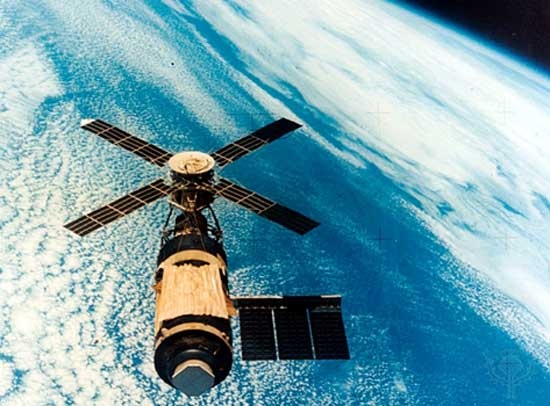 International space endurance recordsOn its launch in May 1973, Skylab's thermal shielding was damaged, which made it necessary for the first crew to carry up and install an improvised “parasol” to allow the station to function at its planned level of operation. Over an eight-and-a-half-month period, Skylab hosted a trio of three-man crews for a total of nearly six months. Its final crew set an endurance record of almost three months; in the process, it undertook a detailed study of how the human body adapts to prolonged exposure to weightlessness—the Skylab program's most significant legacy. (For a list of human endurance records in space, see the table (International space endurance records).)
International space endurance recordsOn its launch in May 1973, Skylab's thermal shielding was damaged, which made it necessary for the first crew to carry up and install an improvised “parasol” to allow the station to function at its planned level of operation. Over an eight-and-a-half-month period, Skylab hosted a trio of three-man crews for a total of nearly six months. Its final crew set an endurance record of almost three months; in the process, it undertook a detailed study of how the human body adapts to prolonged exposure to weightlessness—the Skylab program's most significant legacy. (For a list of human endurance records in space, see the table (International space endurance records).) Maturation of the Soviet station program
After failed attempts to establish a second station, the U.S.S.R. managed a 16-day tour in July 1974 by a two-man crew aboard Salyut 3. This military reconnaissance variant resembled its predecessor but had its docking system at the rear rather than at the front.
The Soviet program achieved the operationally significant milestone of reoccupying a space station in 1975 when two crews lived aboard Salyut 4 for 30 and 63 days, respectively, and conducted scientific experiments. By the time Salyut 4 was abandoned, its environmental system had been exhausted, and the internal walls reportedly were laced with a smelly green mold. It served one final function, however, by receiving the prototype of an automated, unmanned form of the Soyuz spacecraft, called Progress, that was being developed to resupply future stations.
Salyut 5, occupied by two crews in 1976 and 1977, was another reconnaissance platform. Salyut 6, launched in September 1977, introduced the second generation of Soviet space stations. It had a docking system at each end, which permitted Progress resupply ferries to link with an occupied station—i.e., while the crew's Soyuz was docked at the opposite end. The primary objective of this phase of the program was to extend crew endurance gradually in order to demonstrate that humans could survive in weightlessness for the length of time required for a round-trip journey to Mars, which was considered to be as long as 18 months.
A major problem facing the endurance program was that the contemporary variant of the now-venerable Soyuz was limited to a two-month stay in space; beyond this time, its propellant system would deteriorate. This meant that, for a Salyut crew to remain aboard longer, its ferry would have to be replaced periodically. As a solution, endurance crews not only received Progress ferries but also hosted a succession of visitors who would arrive in a fresh Soyuz, stay for a week or so, and then leave in the older Soyuz so that a usable crew-return craft was always available. By supporting crews for 684 days over a four-year period (with five long-duration crews unloading a dozen resupply craft and hosting 11 visiting crews), Salyut 6 greatly advanced the state of the art in space station operations. One indicator of the rapid maturation of the Soviet program came when the two resident cosmonauts made an impromptu space walk in August 1979 to cut away the frame of a radio telescope that had become fouled at the rear of the station.
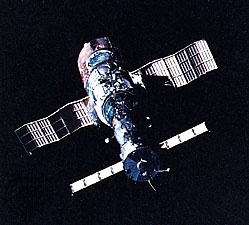 A virtual copy of its predecessor, Salyut 7 was launched in April 1982. While extending the endurance record, a succession of crews were scheduled to occupy the station on a continuous basis, handing it over in an operational state. The cosmonauts' tours of duty would be more lonely because upgrades to the Soyuz—in its new guise it was called Soyuz T—allowed it to remain in space for six months, which obviated the need for frequent visitors. On the other hand, life aboard would be more sociable because weight reduction had enabled the ferry's third seat to be reinstated. Most of the scientific apparatus to keep Salyut 7's crews busy was to be delivered in large modules that would dock temporarily with the station. Salyut 7 received two such modules—Cosmos 1443 in 1983 and Cosmos 1686 in 1985—on its front docking system.
A virtual copy of its predecessor, Salyut 7 was launched in April 1982. While extending the endurance record, a succession of crews were scheduled to occupy the station on a continuous basis, handing it over in an operational state. The cosmonauts' tours of duty would be more lonely because upgrades to the Soyuz—in its new guise it was called Soyuz T—allowed it to remain in space for six months, which obviated the need for frequent visitors. On the other hand, life aboard would be more sociable because weight reduction had enabled the ferry's third seat to be reinstated. Most of the scientific apparatus to keep Salyut 7's crews busy was to be delivered in large modules that would dock temporarily with the station. Salyut 7 received two such modules—Cosmos 1443 in 1983 and Cosmos 1686 in 1985—on its front docking system.Unfortunately, whereas Salyut 6 had had a run of exceptionally good luck, Salyut 7's very ambitious program was frustrated by a series of operational problems. Nevertheless, crews successfully undertook repairs of malfunctions so serious that, until they actually had been faced and overcome, they would have been considered cause to vacate the station. After a pipe of the space station's engine developed a propellant leak, specialized tools were fabricated and sent up, and members of the station's third main crew spacewalked in May 1984 to install a bypass. In February 1985, while temporarily vacant, Salyut 7 suffered a total power failure and started to drift. Four months later, after making a rendezvous without the assistance of the station's radar docking system, the fourth main crew managed to link their Soyuz T-13 with the inert station and restore it to life. Various setbacks had caused the first three crews to leave the station unattended, and the objective of an in-space handover was not achieved until the Soyuz T-14 crew arrived in September 1985 with the Soyuz T-13 cosmonauts still in residence. Salyut 7's bad luck continued to the end; when one of the Soyuz T-14 cosmonauts fell ill, the crew was recalled to Earth.
Mir
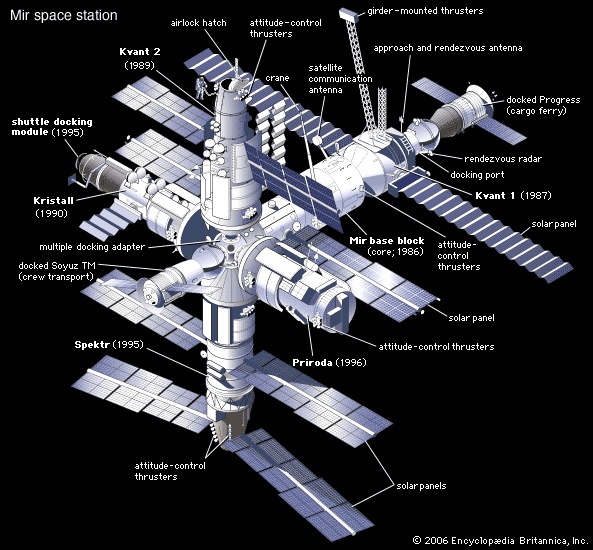 Soviet officials decided to scrap the jinxed Salyut 7 and advance to the next phase, which was to assemble a large modular complex in orbit. At its core would be a base block derived from the Salyut design, which would be outfitted as the crew habitat. In addition to a pair of axial docking systems, it would have a ring of four peripheral docking units around its nose to accept modules mounted at right angles to the base block. Five add-on units would expand the station and provide its primary scientific instruments. To mark the advance, the new station was called Mir (Russian: “peace,” “community,” or “world.”)
Soviet officials decided to scrap the jinxed Salyut 7 and advance to the next phase, which was to assemble a large modular complex in orbit. At its core would be a base block derived from the Salyut design, which would be outfitted as the crew habitat. In addition to a pair of axial docking systems, it would have a ring of four peripheral docking units around its nose to accept modules mounted at right angles to the base block. Five add-on units would expand the station and provide its primary scientific instruments. To mark the advance, the new station was called Mir (Russian: “peace,” “community,” or “world.”)Mir's base block, launched in February 1986, was placed into the same orbital plane as Salyut 7. This allowed Mir's commissioning crew to shuttle between the two stations in their Soyuz T in order to wrap up Salyut 7's program and salvage usable apparatus from the older station. Like Salyut 7, Mir was intended to be occupied on a continuous basis, but delays in building the first of the add-on modules led to the station's being vacated for a time. When the second crew set off for Mir in February 1987, it was in a new form of Soyuz, called Soyuz TM. In April the cosmonauts received the first of the expansion modules, Kvant 1.
International space endurance recordsMounted at the rear of the Mir base block, Kvant 1 was primarily an astrophysical observatory, but it also provided systems for attitude control and life support and carried a docking system at the rear for ferries. The second add-on, Kvant 2, carried additional life-support systems and a large air lock. It was first docked axially at the front of the station and then swung around to a perpendicular position by a mechanical arm, an adjustment that made the station L-shaped. Docking of the third module, Kristall, a materials-processing factory, transformed the L configuration into a T. Beginning in September 1989, Mir was continuously inhabited for nearly a decade by a succession of crews. Although in most cases they served a standard six-month tour of duty, Valery Polyakov (Polyakov, Valery Vladimirovich), a physician, spent a record 14 months aboard in 1994–95. (For a list of human endurance records in space, see the table (International space endurance records).)
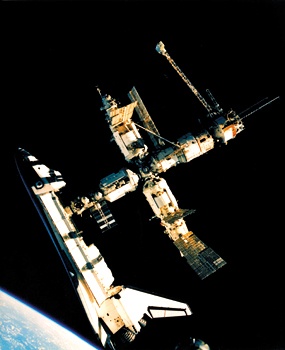 It had been hoped to complete Mir within three years, use it for several years, and then start assembly of its successor by utilizing the Soviet version of the U.S. space shuttle, called Buran, then under development. By the time Kristall was added in mid-1990, however, the base block already was approaching its five-year design life. Delays in developing Buran meant that Mir's service life would have to be extended. Then in 1991, on the demise of the Soviet Union, Buran was canceled and funding for Mir reduced. Facing a financial crisis, the newly created Russian Space Agency offered Mir to the international community as a microgravity research laboratory, selling time aboard it for a fee. In the early 1990s, several of Europe's space agencies accepted the offer and sent astronauts to Mir to conduct a variety of microgravity studies.
It had been hoped to complete Mir within three years, use it for several years, and then start assembly of its successor by utilizing the Soviet version of the U.S. space shuttle, called Buran, then under development. By the time Kristall was added in mid-1990, however, the base block already was approaching its five-year design life. Delays in developing Buran meant that Mir's service life would have to be extended. Then in 1991, on the demise of the Soviet Union, Buran was canceled and funding for Mir reduced. Facing a financial crisis, the newly created Russian Space Agency offered Mir to the international community as a microgravity research laboratory, selling time aboard it for a fee. In the early 1990s, several of Europe's space agencies accepted the offer and sent astronauts to Mir to conduct a variety of microgravity studies.Revival of the U.S. station program
In 1969, NASA proposed to President Nixon that a reusable space shuttle be developed to serve as the basis for post-Apollo activities in Earth orbit. At that time, still pursuing Braun's vision of a space plane and complementary orbiting base, the agency had hoped to use the shuttle to build a space station, but the high cost of funding the first project precluded starting the second. Once the shuttle was in service, however, the agency again began lobbying for a station. In 1984, President Ronald Reagan (Reagan, Ronald W.) ordered that a space station be developed within a decade and that it involve international participation. Unfortunately, because of legislative disputes over the station's design and cost and various setbacks to NASA's overall space program, no actual construction was begun during the assigned period.
In 1993, as the prospect of cancellation loomed, President Bill Clinton (Clinton, Bill) ordered NASA to widen the multinational partnership by including Russia, with which relations had dramatically improved following the end of the Cold War. In an extension of that spirit of cooperation, the United States and Russia agreed to merge their respective space station developments into a program for a single orbital structure. The first phase of the integrated program called for a series of shuttle missions to Mir to allow NASA to gain practical experience operating in conjunction with a station and to make an early start on microgravity research. With this renewal of effort, Russia launched its last two modules, named Spektr and Priroda, to Mir. In 1996, a decade after its assembly began, Mir was finally completed.
The International Space Station
NASA's interest in Mir was strictly as a stepping-stone, and it intended soon after the final shuttle-Mir mission in early 1998 to put into orbit the first element of its multinational project, which had come to be called the International Space Station (ISS). Launched by Russia atop a Proton rocket in late 1998, the initial module, called Zarya, was designed to provide attitude control and solar power arrays for the nascent station. Shortly afterward, space shuttle astronauts ferried up and attached the first U.S.-built element, named Unity, a connecting node with multiple docking systems.
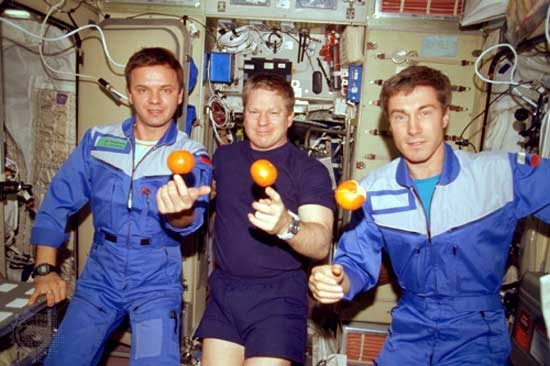 Development difficulties delayed the launch of the next ISS element, Zvezda, a crew habitat and control centre similar to the Mir base block, until mid-2000. Two weeks after it was carried up on a Proton rocket, Zvezda rendezvoused and docked automatically at the trailing end of Zarya. Later in the year, the first resident ISS crew, comprising two Russians and an American, arrived in a Soyuz TM. Subsequent installation of a large solar power array and cooling radiators on a truss mounted on Unity cleared the way for the shuttle launch of NASA's microgravity laboratory, Destiny, in early 2001. The addition of Destiny, which astronauts mated to the leading end of Unity, marked a milestone in the project because it facilitated science operations. Other components were subsequently appended. After the catastrophic explosion of the shuttle orbiter Columbia in 2003 and the consequent temporary grounding of the shuttle fleet, activity aboard the ISS was reduced virtually to a caretaker level, while Soyuz spacecraft provided the sole means for station crew exchanges.
Development difficulties delayed the launch of the next ISS element, Zvezda, a crew habitat and control centre similar to the Mir base block, until mid-2000. Two weeks after it was carried up on a Proton rocket, Zvezda rendezvoused and docked automatically at the trailing end of Zarya. Later in the year, the first resident ISS crew, comprising two Russians and an American, arrived in a Soyuz TM. Subsequent installation of a large solar power array and cooling radiators on a truss mounted on Unity cleared the way for the shuttle launch of NASA's microgravity laboratory, Destiny, in early 2001. The addition of Destiny, which astronauts mated to the leading end of Unity, marked a milestone in the project because it facilitated science operations. Other components were subsequently appended. After the catastrophic explosion of the shuttle orbiter Columbia in 2003 and the consequent temporary grounding of the shuttle fleet, activity aboard the ISS was reduced virtually to a caretaker level, while Soyuz spacecraft provided the sole means for station crew exchanges.The overall plan for the ISS called for assembly of a complex of habitable modules crossed by a long truss that supported four large solar power arrays. Among major elements scheduled for later installation were specialized laboratories supplied by the European Space Agency and the National Space Development Agency of Japan. Much of the early scientific work aboard the station focused on life sciences and materials sciences research in the weightless environment. Although ungainly compared with the elegant space wheels envisioned at the start of the space age, the ISS was expected to serve as the basis for human operations in Earth orbit for at least the first quarter of the 21st century.
Additional Reading
Piers Bizony, Island in the Sky: Building the International Space Station (1996), offers a glossy preview of the assembly of the ISS. Brian Harvey, Russia in Space: The Failed Frontier? (2001), is a retrospective on the demise of the Russian space program during the 1990s and on the transition from Mir to the ISS. W. David Compton and Charles D. Benson, Living and Working in Space: A History of Skylab (1983), is the official NASA history of the Skylab program. The Salyut and Mir programs are covered comprehensively in David M. Harland, The Mir Space Station: A Precursor to Space Colonization (1997). Phillip Clark, The Soviet Manned Space Program (1988), provides an excellent portrait of the Salyut era. Marsha Freeman, Challenges of Human Space Exploration (2000), assesses the human and institutional challenges that were faced by the shuttle-Mir program.
- Étienne de La Ville-sur-Illon, comte de Lacépède
- Étienne de La Ville-sur-Illon Lacépède, comte de
- Étienne Dolet
- Étienne, duc de Pasquier
- Étienne-François de Choiseul Choiseul, duc de
- Étienne-François de Choiseul, duc de Choiseul
- Étienne-François Geoffroy
- Étienne Geoffroy Saint-Hilaire
- Étienne Gilson
- Étienne Jodelle
- Étienne-Jules Marey
- Étienne Lenoir
- Étienne-Louis Boullée
- Étienne-Louis Malus
- Étienne Marcel
- Étienne-Maurice Falconet
- Étienne-Nicolas Méhul
- Étienne Pasquier
- Étienne Pasquier, duc de
- Étienne Pivert de Senancour
- Évariste Galois
- Évian-les-Bains
- Évora
- Évreux
- Évry